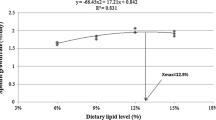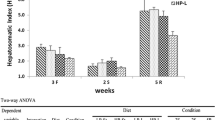Abstract
A 12-week feeding trial was conducted to examine the effects of dietary protein concentrations on growth, whole-body chemical composition, and hepatic anti-oxidant enzyme activities of coho salmon Oncorhynchus kisutch (Walbaum, 1792) alevins. Five experimental diets were formulated with graded protein levels of 36.5%, 42.0%, 48.0%, 54.5%, and 60.0%, respectively, with each fed to triplicate groups of fish (0.36 ± 0.01 g). Stocked as groups of 50 individuals per tank (water volume of 240 L), fish were fed four times daily with the method of overfeeding (15–20% body weight). After the feeding trial, the specific growth rate (SGR) in groups fed diets with 48.0%, 54.5%, and 60.0% protein was significantly higher than that in the 36.5% protein group (P < .05). The feed conversion ratio (FCR) in 48.0%, 54.5%, and 60.0% dietary protein groups was significantly lower than that in the 36.5% protein group (P < .05). No significant differences were observed for hepatosomatic index (HSI), intestosomatic index (ISI), condition factor (CF), and whole-body composition, except the crude protein content, which increased significantly with the increment of dietary protein level up to 48.0% (P < .05) and then leveled off (P > .05). Dietary protein up to 48.0% significantly increased the activities of total superoxide dismutase (T-SOD) and catalase (CAT) and significantly decreased the malondialdehyde (MDA) contents in the liver (P < .05). The second-order polynomial regression analyses based on SGR indicated that the optimal protein requirement in diets of coho salmon alevins was 53.6%, which was concurrent with a protein to energy ratio of 25.8 g protein MJ−1.


Similar content being viewed by others
Data availability
All the data in the article are available from the corresponding author upon reasonable request.
References
Abbas G, Siddiqui PJ (2013) The effects of varying dietary protein level on growth, feed conversion, body composition and apparent digestibility coefficient of juvenile mangrove red snapper, Lutjanus argentimaculatus (Forsskal 1775). Aquac Res 44:807–818. https://doi.org/10.1111/j.1365-2109.2012.03096.x
Ahmed I, Ahmad I (2020) Effect of dietary protein levels on growth performance, hematological profile and biochemical composition of fingerlings rainbow trout, Oncorhynchus mykiss reared in Indian Himalayan region. Aquac Rep 16:100268. https://doi.org/10.1016/j.aqrep.2019.100268
Ai Q, Mai K, Li H, Zhang C, Zhang L, Duan Q, Tan B, Xu W, Ma H, Zhang W, Liufu Z (2004) Effect of dietary protein to energy ratios on growth and body composition of juvenile Japanese seabass, Lateolabrax japonicus. Aquaculture 230:507–516. https://doi.org/10.1016/j.aquaculture.2003.09.040
Ali MZ (1822) Jauncey K (2005) Approaches to optimizing dietary protein to energy ratio for African catfish Clarias gariepinus (Burchell. Aquac Nutr 11(2):95–101. https://doi.org/10.1111/j.1365-2095.2004.00325.x
Ali A, Al-Ogaily SM, Al-Asgah NA, Goddard JS, Ahmed SI (2008) Effect of feeding different protein to energy (P/E) ratios on the growth performance and body composition of Oreochromis niloticus fingerlings. J Appl Ichthyol 24(1):31–37. https://doi.org/10.1111/j.1439-0426.2007.00897.x
AOAC (1995) Official methods of analysis of the association of analytical chemistry, 16th edn. Association of Official Analytical Chemists, Washington
Buege JA, Aust SD (1978) Microsomal lipid peroxidation. Meth Enzymol 52:302–310. https://doi.org/10.1016/s0076-6879(78)52032-6
Company R, Calduch-Giner JA, Kaushik S, Pérez-Sánchez J (1999) Growth performance and adiposity in gilthead sea bream (Sparus aurata): risk and benefits of high fat diets. Aquaculture 171:279–292. https://doi.org/10.1016/s0044-8486(98)00495-5
Cowey CB (1995) Intermediary metabolism in fish with reference to output of end products of nitrogen and phosphorus. Water Sci Technol 31:21–28. https://doi.org/10.1016/0273-1223(95)00423-k
Craig S, Helfrich LA, Kuhn D, Schwarz MH (2017) Understanding Fish Nutrition, Feeds and Feeding (Publication 420–256). Virginia Cooperative Extension, Yorktown (Virginia).
Jauncey K (1982) The effects of varying dietary protein level on the growth, food conversion, protein utilization and body composition of juvenile tilapias (Sarotherodon mossambicus). Aquaculture 27:43–54. https://doi.org/10.1016/0044-8486(82)90108-9
Jayant M, Muralidhar AP, Sahu NP, Jain KK, Pal AK, Srivastava PP (2018) Protein requirement of juvenile striped catfish, Pangasianodon hypophthalmus. Aquac Int 26:375–389. https://doi.org/10.1007/s10499-017-0216-0
Jiang S, Wu X, Luo Y, Wu M, Lu S, Jin Z, Yao W (2016) Optimal dietary protein level and protein to energy ratio for hybrid grouper (Epinephelus fuscoguttatus ♀ × Epinephelus lanceolatus ♂) juveniles. Aquaculture 465:28–36. https://doi.org/10.1016/j.aquaculture.2016.08.030
Khan IA, Maqbool A (2017) Effects of dietary protein levels on the growth, feed utilization and haemato-biochemical parameters of freshwater fish, Cyprinus Carpio Var. Specularis. Fish Aquac J 8:187. https://doi.org/10.4172/2150-3508.1000187
Kim SS, Lee KJ (2009) Dietary protein requirement of juvenile tiger puffer (Takifugu rubripes). Aquaculture 287(1–2):219–222. https://doi.org/10.1016/j.aquaculture.2008.10.021
Kim KW, Wang XJ, Bai SC (2002) Optimal dietary protein level for maximum growth of juvenile olive flounder Paralichthys olivaceus (Temminck et Schlegel). Aquac Res 33:673–679. https://doi.org/10.1046/j.1365-2109.2002.00704.x
Kim KW, Kim KD, Han HS, Moniruzzaman M, Yun H, Lee S, Bai SC (2017) Optimum dietary protein level and protein-to-energy ratio for growth of juvenile parrot fish, Oplegnathus Fasciatus. J World Aquac Soc 48(3):467–477. https://doi.org/10.1111/jwas.12337
Kpundeh MD, Qiang J, He J, Yang H, Xu P (2015) Effects of dietary protein levels on growth performance and haemato-immunological parameters of juvenile genetically improved farmed tilapia (GIFT), Oreochromis Niloticus. Aquac Int 23(5):1189–1201. https://doi.org/10.1007/s10499-014-9876-1
Lee SM, Kim KD (2001) Effects of dietary protein and energy levels on the growth, protein utilization and body composition of juvenile masu salmon (Oncorhynchus masou Brevoort). Aquac Res 32:39–45. https://doi.org/10.1046/j.1355-557x.2001.00004.x
Lee HM, Cho KC, Lee JE, Yang SG (2001) Dietary protein requirement of juvenile giant croaker, Nibea japonica Temminck & Schlegel. Aquac Res 32:112–118. https://doi.org/10.1046/j.1355-557x.2001.00050.x
Liu X, Mai K, Liufu Z, Ai Q (2015) Dietary protein requirement of juvenile turbot (Scophthalmus maximus Linnaeus). J Ocean Univ China 14:325–328. https://doi.org/10.1046/j.1365-2095.2003.00255.x
Ma R, Liu X, Meng Y, Wu J, Zhang L, Han B, Qian K, Luo Z, Wei Y, Li C (2019) Protein nutrition on sub-adult triploid rainbow trout (1): Dietary requirement and effect on anti-oxidative capacity, protein digestion and absorption. Aquaculture 507:428–434. https://doi.org/10.1016/j.aquaculture.2019.03.069
Matés JM (2000) Effects of antioxidant enzymes in the molecular control of reactive oxygen species toxicology. Toxicology 153(1–3):83–104. https://doi.org/10.1016/s0300-483x(00)00306-1
Meng Y, Li C, Qin Q, Tong Y, Zhu R, Xu G, Shi Y, Shi J, Ma R (2018) Dietary lipid levels affect the growth performance, lipid deposition, and antioxidative capacity of juvenile scaleless carp, Gymnocypris przewalskii, on the Qinghai-Tibetan plateau. J World Aquac Soc 49(4):788–797. https://doi.org/10.1111/jwas.12474
NRC (2011) Nutrient Requirements of Fish and Shrimp. National Academy Press, Washiongton, DC, USA. https://doi.org/10.17226/13039
Ozório ROA, Valente LMP, Correia S, Pousao-Ferreira P, Damasceno-Oliveira A, Escorcio C, Oliva-Teles A (2009) Protein requirement for maintenance and maximum growth of two-banded seabream (Diplodus vulgaris) juveniles. Aquac Nutr 15(1):85–93. https://doi.org/10.1111/j.1365-2095.2008.00570.x
Pascual P, Pedrajas JR, Toribio F, López-Barea J, Peinado J (2003) Effect of food deprivation on oxidative stress biomarkers in fish (Sparus aurata). Chem Biol Interact 145(2):191–199. https://doi.org/10.1016/s0009-2797(03)00002-4
Sahli M, Bessonart M, Chediak G, Bellagamba M, Carnevia D (2004) Growth, feed utilization and body composition of black catfish, Rhamdia quelen, fry fed diets containing different protein and energy levels. Aquaculture 231:435–444. https://doi.org/10.1016/j.aquaculture.2003.08.006
Sheridan MA, Mommsen TP (1991) Effects of nutritional state on in vivo lipid and carbohydrate metabolism of coho salmon, Oncorhynchus Kisutch. Gen Comp Endocrinol 81(3):473–483. https://doi.org/10.1016/0016-6480(91)90175-6
Teles AO, Couto A, Enes P, Peres H (2020) Dietary protein requirements of fish–a meta-analysis. Rev Aquac 12(3):1445–1477. https://doi.org/10.1111/raq.12391
Wang J, Li X, Han T, Yang Y, Jiang Y, Yang M, Xu Y, Harpaz S (2016) Effects of different dietary carbohydrate levels on growth, feed utilization and body composition of juvenile grouper Epinephelus akaara. Aquaculture 459:143–147. https://doi.org/10.1016/j.aquaculture.2016.03.034
Wang L, Hu S, Lou B, Chen D, Zhan W, Chen R, Liu F, Xu D (2018) Effect of different dietary protein and lipid levels on the growth, body composition, and intestinal digestive enzyme activities of juvenile yellow drum Nibea albiflora (Richardson). J Ocean Univ China 17(5):1261–1267. https://doi.org/10.1007/s11802-018-3660-1
Wilson RP (2002) Amino acids and proteins. In: Halver JE, Hardy RW (eds) Fish Nutrition, 3rd edn. Academic Press Inc., San Diego, pp 143–199. https://doi.org/10.1016/b978-012319652-1/50004-5
Wilson RP, Halver JE (1986) Protein and amino acid requirements of fishes. Annu Rev Nutr 6(1):225–244. https://doi.org/10.1146/annurev.nu.06.070186.001301
Winfree RA, Stickney RR (1981) Effects of dietary protein and energy on growth, feed conversion efficiency and body composition of Tilapia aureus. J Nutr 111:1001–1012. https://doi.org/10.1093/jn/111.6.1001
Xu J, Wu P, Jiang WD, Liu Y, Jiang J, Kuang SY, Tang L, Tang WN, Zhang YA, Zhou XQ, Feng L (2016) Optimal dietary protein level improved growth, disease resistance, intestinal immune and physical barrier function of young grass carp (Ctenopharyngodon idella). Fish Shellfish Immunol 55:64–87. https://doi.org/10.1016/j.fsi.2016.05.021
Yengkokpam S, Debnath D, Sahu NP, Pal AK, Jain KK, Baruah K (2016) Dietary protein enhances non-specific immunity, anti-oxidative capability and resistance to Aeromonas hydrophila in Labeo rohita fingerlings pre-exposed to short feed deprivation stress. Fish Shellfish Immunol 59:439–446. https://doi.org/10.1016/j.fsi.2016.10.052
Yu HR, Li LY, Shan LL, Gao J, Ma CY, Li X (2021) Effect of supplemental dietary zinc on the growth, body composition and anti-oxidant enzymes of coho salmon (Oncorhynchus kisutch) alevins. Aquac Rep 20:100744. https://doi.org/10.1016/j.aqrep.2021.100744
Zeitoun IH, Ullrey DE, Halver JE, Tack PI, Magee WT (1974) Influence of salinity on protein requirements of coho salmon (Oncorhynchus kisutch) smolts. Can J Fish Aquat Sci 31(6):1145–1148. https://doi.org/10.1139/f74-132
Zhang M, Yin X, Li M, Qian Y, Wang R, Hong M (2021) Effects of dietary protein and cellulose levels on growth performance, antioxidant status, immune response and inflammation in juvenile yellow catfish (Pelteobagrus fulvidraco). Aquac Res 52(3):924–934. https://doi.org/10.1111/are.14946
Funding
This study was funded by Shandong Provincial Key Research and Development Programs (Major Scientific and Technological Innovation Projects, MSTIP), Grant/Award Numbers: 2018CXGC0102 and 2019JZZY020710; Scientific and Technologic Development Program of Weifang, Grant/Award Number: 2019ZJ1046; Innovation-Driven Development Special Project of Guangxi Science and Technology Major Project, Grant/Award Number: AA17204044; and Shandong Provincial Natural Science Foundation, Grant/Award Number: ZR2020MC174.
Author information
Authors and Affiliations
Corresponding author
Ethics declarations
Ethical approval
The present study was carried out strictly according to the recommendations in the Guide for the Use of Experimental Animals of the Weifang University.
Conflict of interest
The authors declare no competing interests.
Additional information
Publisher's note
Springer Nature remains neutral with regard to jurisdictional claims in published maps and institutional affiliations.
Handling Editor: Gavin Burnell
Rights and permissions
About this article
Cite this article
Xu, Cm., Yu, Hr., Zhang, Q. et al. Effects of dietary protein concentration on growth and anti-oxidant capacity of coho salmon Oncorhynchus kisutch (Walbaum, 1792) alevins. Aquacult Int 30, 1563–1574 (2022). https://doi.org/10.1007/s10499-022-00837-3
Received:
Accepted:
Published:
Issue Date:
DOI: https://doi.org/10.1007/s10499-022-00837-3




